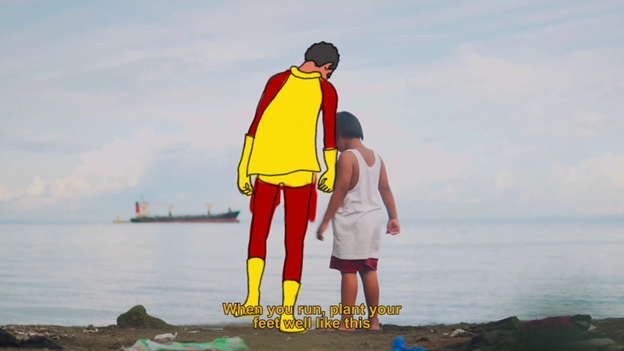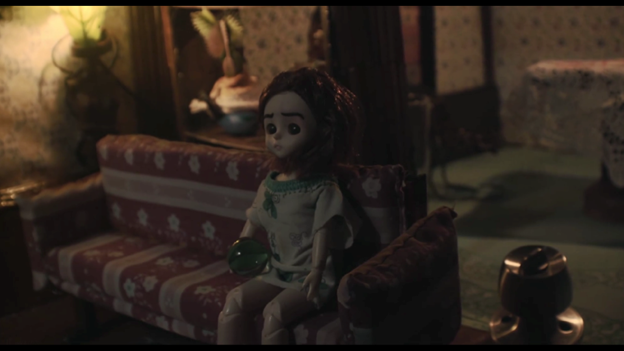by TRIXCY ANNE B. LOSERIAGA
CHILDREN HAVE different stories to tell, whether good or bad. Most of them, however, are buried under the rubble of society’s belief that they are ‘merely children.’ Unfortunately, it is still a common issue that most tend to ignore.
This year’s Pista ng Pelikulang Pilipino features Sine Kabataan, a children-centered compendium that shed light on overlooked childhood experiences.
Boy Kilat
The mixed media short film is about a superhero named Boy Kilat who protects his little brother JunJun from the outside world. Directed by Faith Aragon, the short film tackles sexual exploitation.
According to director Aragon, the superhero theme is a metaphor for children having “a filter from the outside world,” with Boy Kilat acting as JunJun’s shield as they traverse the adult world.
As the film progresses, their brotherly relationship wanes as Boy Kilat starts to prioritize their living expenses. The superhero persona continues to fade and JunJun soon opens his eyes to reality. The same one that Boy Kilat once tried to protect his brother from.
From a technical perspective, some improvements can be made with the lighting as some scenes are too dark for the actors to be seen. Regardless, Boy Kilat is a great eye-opener to the reality that children mature too early for their age.

Tong Adlaw Nga Nag-Snow sa Pinas
It is a black and white film about two boys who are both sexual abuse victims. They are seen as normal children playing with scrap and styrofoam until they show each other their bruises—one on the neck, the other in the arm.
The consequences of sexual abuse are evident. It is shown in the latter half of the film, as the boys try to enjoy their lives while tending to each other’s bruises. The actual beating is never shown in the film. As director Joshua Medroso said, “we don’t want the violence to be glorified but rather, show the consequences of it.”
The black and white setting of the film is perfect in showing its message albeit the lighting needs more work. The actors’ expressions are a little nonchalant as well but they did a great job of portraying a defenseless child in a cruel world.
Hm Hm Mhm
Hm Hm Mhm uses stop-motion animation and dolls to convey a girl’s experience with her family. From a simple family dinner to a distorted feeling of despair surrounding the girl’s world in a matter of seconds, directors Kim Timan and Sam Villa-Real successfully portray childhood trauma.
The film includes the traumatic experiences of losing a sibling from a miscarriage. It is accompanied by a creepy setting and uncanny tone to further expound on a sister’s despair of losing someone important. While the dolls have managed to present themselves from a normal family to a terrifying bundle of horror.
Although the film did not use any dialogue, the message of healing from traumatic experiences is evident. The distortions used are a little redundant but express the family’s turmoil.

Unsolved Equation
Regrets and what-ifs are the core of Dexter Paul De Jesus’ short film.
It starts with two students preparing for a math competition. One of them is accompanied by his father, a jeepney driver. As the story goes, it portrays the insecurities of the boy: the inability to perform well in the competition and being unable to invite his father to watch the competition.
Past regrets bounce back as the projection shows the son dragging his father somewhere along the road. As stated by the director, “going down the memory lane.” The student did a great job in portraying someone in distress and anxiety.
The film reminds its audience to always grab the opportunity, no matter how inconvenient it may seem.
Friends and Rainy Days
Pinky promises are meant to be broken, but not in director Raiza Masculino’s Friends and Rainy Days, a slice-of-life short film about friendship and promises.
Jenna and Tina are friends but they rarely see each other due to school. One day, they are given the chance to play with each other as their vacation is still underway. They play inside a jeep, gather stones by the river, and draw a hopscotch on the street. However, they never get the chance to play.
Accompanied by solemn music, the film portrays how small actions affect a child and how it shapes them in the future. The usage of rain portrays the missed opportunities to be with friends who can help shape them up to be better people, especially since the pandemic forced most citizens to stay indoors.
Sine Kabataan utilizes some of the everyday childhood experiences that most adults tend to forget. Children are often ignored when they try to raise an issue with adults since the adult’s mindset is “bata lang yan,” not knowing that their actions contribute to a child’s growth. Oftentimes, these children never heal from their trauma and it is passed on to their children—should they want to have one in the future.
These five-minute short films are confirmation that children do have a voice confined within the depths of generational trauma. F



